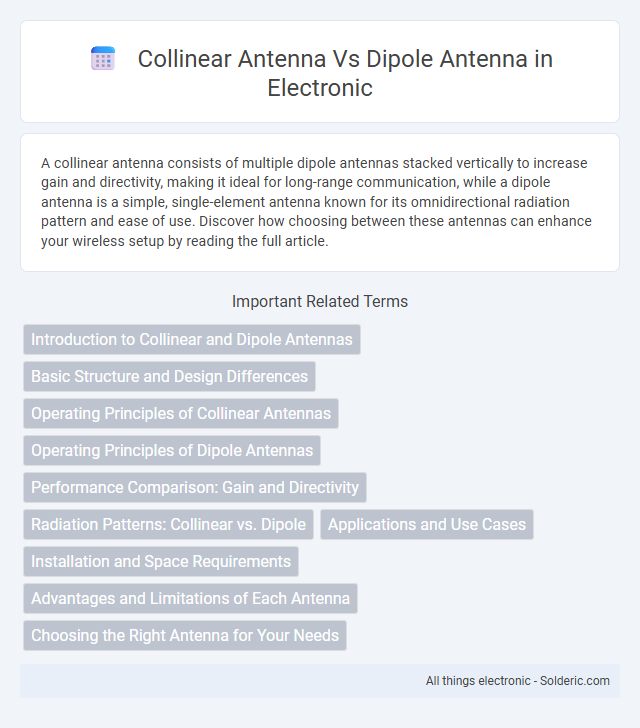A collinear antenna consists of multiple dipole antennas stacked vertically to increase gain and directivity, making it ideal for long-range communication, while a dipole antenna is a simple, single-element antenna known for its omnidirectional radiation pattern and ease of use. Discover how choosing between these antennas can enhance your wireless setup by reading the full article.
Comparison Table
| Feature | Collinear Antenna | Dipole Antenna |
|---|---|---|
| Design | Stacked half-wave elements aligned vertically | Single half-wave element, typically horizontal |
| Radiation Pattern | Omnidirectional, enhanced vertical gain | Bidirectional, figure-eight horizontal pattern |
| Gain | Higher gain (typically 6-9 dBi) | Lower gain (approximately 2.15 dBi) |
| Frequency Range | Commonly VHF and UHF bands | Wideband, applicable across HF, VHF, UHF |
| Application | Base stations, cellular, marine, and radio repeaters | General purpose, broadcasting, ham radio, mobile |
| Size | Longer due to stacked elements | Shorter and simpler |
| Polarization | Vertical polarization | Usually horizontal polarization |
| Complexity | More complex construction | Simple and easy to build |
Introduction to Collinear and Dipole Antennas
Collinear antennas consist of multiple dipole elements arranged in a vertical line, designed to enhance gain and provide an omnidirectional radiation pattern ideal for VHF and UHF communications. Dipole antennas feature a simple, half-wavelength conductor with balanced feed, commonly used for foundational radio frequency transmission and reception. The collinear design increases effective radiated power by stacking dipoles, improving signal range and strength compared to a single dipole antenna.
Basic Structure and Design Differences
A collinear antenna consists of multiple dipole elements stacked vertically and connected in phase to increase gain and directivity, whereas a dipole antenna is typically a single half-wavelength element with two conductive rods. The collinear design enhances vertical radiation patterns suitable for long-distance communication, while the dipole offers a simpler, omnidirectional pattern. Structurally, collinear antennas require careful phasing and support for multiple elements, contrasting with the straightforward, symmetrical layout of a standard dipole.
Operating Principles of Collinear Antennas
Collinear antennas operate by stacking multiple half-wave dipole elements vertically in phase, which increases their combined gain and directivity compared to a single dipole antenna. This arrangement enhances your signal strength and coverage, particularly in horizontal directions, by focusing energy along the antenna's axis. The collinear design reduces ground wave attenuation and is ideal for applications requiring extended range and uniform radiation patterns.
Operating Principles of Dipole Antennas
Dipole antennas operate by generating electromagnetic waves through a pair of conductive elements driven by an alternating current, creating radiation patterns primarily broadside to the antenna axis. Collinear antennas, in contrast, consist of multiple dipole elements vertically stacked and phased to produce a high-gain, omnidirectional pattern in the horizontal plane. Understanding the operating principles of dipole antennas is essential for optimizing Your communication system's performance, especially when choosing between simpler dipoles and more complex collinear arrays.
Performance Comparison: Gain and Directivity
Collinear antennas typically offer higher gain and more focused directivity compared to dipole antennas due to their stacked element design, which enhances signal strength and range. Dipole antennas provide more omnidirectional radiation patterns with moderate gain, suitable for broader coverage but less focused signal transmission. The increased gain of collinear antennas makes them ideal for long-distance communication, while dipole antennas are preferred for applications requiring uniform coverage.
Radiation Patterns: Collinear vs. Dipole
Collinear antennas produce a high-gain, omnidirectional radiation pattern with enhanced vertical beamwidth, making them ideal for long-distance, horizontal signal propagation. Dipole antennas exhibit a figure-eight radiation pattern perpendicular to the antenna axis, with nulls along the axis, limiting their effective coverage area. The collinear design stacks multiple dipole elements in phase, resulting in increased gain and reduced signal fading compared to a single dipole antenna.
Applications and Use Cases
Collinear antennas are widely used in applications requiring high gain and omnidirectional coverage, such as cellular base stations, public safety communications, and Wi-Fi networks, where consistent horizontal signal strength over long distances is essential. Dipole antennas are favored in simpler or portable setups like handheld radios, television reception, and amateur radio, offering balanced radiation patterns with moderate gain suitable for point-to-point or short-range communication. Your choice between collinear and dipole antennas depends on the need for extended range and network coverage versus ease of deployment and versatility in various frequency bands.
Installation and Space Requirements
Collinear antennas require vertical stacking of multiple dipole elements, demanding more vertical space and careful alignment during installation to maximize gain and signal range. Dipole antennas have simpler installation needs with horizontal or vertical mounting options, making them suitable for tighter or more constrained spaces. Your choice depends on available installation space and the desired antenna performance for your specific application.
Advantages and Limitations of Each Antenna
Collinear antennas offer high gain and improved signal coverage by stacking multiple dipole elements in phase, making them ideal for applications requiring extended range and uniform radiation patterns, but they tend to be larger and more complex to manufacture. Dipole antennas provide simplicity, low cost, and ease of installation with a broad frequency response, yet they suffer from lower gain and less focused radiation compared to collinear arrays. The choice between collinear and dipole antennas depends on specific needs such as range, installation constraints, and budget considerations.
Choosing the Right Antenna for Your Needs
Collinear antennas provide high-gain and omni-directional coverage, making them ideal for long-distance communication in applications such as cellular networks and Wi-Fi systems. Dipole antennas offer a simpler design with moderate gain and directional characteristics, suitable for localized or point-to-point communication needs. Selecting between these antennas depends on the required coverage area, gain, and installation environment, ensuring optimal performance for specific use cases.
collinear antenna vs dipole antenna Infographic

 solderic.com
solderic.com